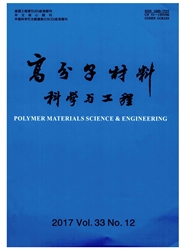

 中文摘要:
中文摘要:
以N-苯基马来酰亚胺(NPMI)和4-乙烯基吡啶-醋酸锌配合物(4VP-Zn(Ac)2)为单体,用可逆断裂链转移聚合(RAFT)方法合成了两亲性聚(N-苯基马来酰亚胺)-b-聚(4-乙烯基吡啶)-ZnS(PNPMI-b-P4VP-ZnS)高分子纳米复合物(PNCs),用核磁共振(NMR)、X射线衍射(XRD)、扫描电镜(SEM)和透射电镜(TEM)等对产物进行了表征。随着RAFT嵌段聚合时间由1 h增加到30 h,PNPMI-b-P4VP-ZnS中ZnS的质量分数由8.2%提高到12.6%,ZnS粒径由3 nm增大到200 nm,并由立方向六方晶型转变,复合物中PNPMI-b-P4VP的荧光强度逐渐下降,而ZnS的荧光强度逐渐增大。研究表明,RAFT方法可有效调控PNPMI-b-P4VP和ZnS之间的荧光共振能量转移。PNPMI-b-P4VP-ZnS在生物研究领域具有潜在的应用价值。
 英文摘要:
英文摘要:
The amphipathic poly(N-phenylmaleimide)-b-poly(4-vinylpyridine)-zinc acetate(PNPMI-b-P4VP-Zn(Ac)2) complex has been synthesized by reversible addition fragmentation chain transfer(RAFT) polymerization,using N-phenylmaleimide and 4-vinylpyridine-zinc acetate(4VP-Zn(Ac)2) as monomers.The products as prepared have been characterized by nuclear magnetic resonance spectrum(NMR),X-ray diffraction(XRD),scanning electron microscope(SEM) and transmission electron microscope(TEM).The ZnS mass fraction increases from 8.2% to 12.6% with the block copolymerization time increasing from 1h to 30h.The particle size of ZnS also increases from 3 nm to 200 nm,accompanied with the crystal style conversion of ZnS from cubic to hexagonal.The photoluminescence(PL) intensity of PNPMI-b-P4VP decreases with the increasing block copolymerization time,however,the PL intensity of ZnS increases.Results show that,the fluorescence resonance energy transfer properties between PNPMI-b-P4VP and ZnS are controllable by RAFT method.The PNPMI-b-P4VP-ZnS FRET probe shows a potential application in the biologic field.
 同期刊论文项目
同期刊论文项目
 同项目期刊论文
同项目期刊论文
 First example of polystyrene end-functionalized with excited state intramolecular proton transfer (E
First example of polystyrene end-functionalized with excited state intramolecular proton transfer (E Atom transfer radical polymerization of MMA initiated by 2-(4-chloromethyl-phenyl)-benzoxazole and f
Atom transfer radical polymerization of MMA initiated by 2-(4-chloromethyl-phenyl)-benzoxazole and f Synthesis and optical properties of poly[(4-(benzoxazole-2-yl)phenyl)methyl methacrylate] with 1,8-n
Synthesis and optical properties of poly[(4-(benzoxazole-2-yl)phenyl)methyl methacrylate] with 1,8-n Polymerization of methyl methacrylate catalyzed by macromolecule-copper (II) complex in sodium sulfi
Polymerization of methyl methacrylate catalyzed by macromolecule-copper (II) complex in sodium sulfi Synthesis and photophysical properties of fluorescent polystyrene containing 1,8-naphthalimide via a
Synthesis and photophysical properties of fluorescent polystyrene containing 1,8-naphthalimide via a Synthesis and Fluorescent Properties of End-Functional PSt Initiated by 5-Chloromethyl-2-methoxy-ben
Synthesis and Fluorescent Properties of End-Functional PSt Initiated by 5-Chloromethyl-2-methoxy-ben Influence of coanions on construction of copper(II)/ 4,4'-dipyridyl sulfide(dps) coordination polyme
Influence of coanions on construction of copper(II)/ 4,4'-dipyridyl sulfide(dps) coordination polyme Synthesis and the Third-order Nonlinear Optical Properties of New Azobenzene-Containing Side-Chain p
Synthesis and the Third-order Nonlinear Optical Properties of New Azobenzene-Containing Side-Chain p Synthesis of Optical-active Azo-containing Acrylates Using Atom Transfer Radical Polymerization unde
Synthesis of Optical-active Azo-containing Acrylates Using Atom Transfer Radical Polymerization unde ATRP of MMA initiated by 2-bromomethyl-4,5-diphenyloxazole at room temperatureand study of fluoresce
ATRP of MMA initiated by 2-bromomethyl-4,5-diphenyloxazole at room temperatureand study of fluoresce Synthesis, structures and NLO properties of five non-centrosymmetric coordination compounds from the
Synthesis, structures and NLO properties of five non-centrosymmetric coordination compounds from the Synthesis of AB type block copolymers containing benzoxazole and anthracene groups by ATRP and fluor
Synthesis of AB type block copolymers containing benzoxazole and anthracene groups by ATRP and fluor Synthesis?ofThird-order?Nonlinear?Optical?Polyacrylates?Containing?an?Azobenzene
Side?Chain?via?Atom
Synthesis?ofThird-order?Nonlinear?Optical?Polyacrylates?Containing?an?Azobenzene
Side?Chain?via?Atom Facile di-color emission tuning of poly[1-(4-vinylstyryl)naphthalene]with naphthalimide end group vi
Facile di-color emission tuning of poly[1-(4-vinylstyryl)naphthalene]with naphthalimide end group vi Synthesis and the third-order nonlinear optical properties of the soluble polymers with different su
Synthesis and the third-order nonlinear optical properties of the soluble polymers with different su Hydrothermal Synthesis,Structure and Luminescent Properties of 2D [Ag(4-pytz)]∞ Coordination Polymer
Hydrothermal Synthesis,Structure and Luminescent Properties of 2D [Ag(4-pytz)]∞ Coordination Polymer A novel pH-sensitive polymeric fluorescent probe: Synthesis, characterization and optical properties
A novel pH-sensitive polymeric fluorescent probe: Synthesis, characterization and optical properties Synthesis, third-order nonlinear optical (NLO) properties of polystyrene containing 1,8-naphthalimid
Synthesis, third-order nonlinear optical (NLO) properties of polystyrene containing 1,8-naphthalimid Synthesis, characterization and fluorescence adjustment of well-defined polymethacrylates with penda
Synthesis, characterization and fluorescence adjustment of well-defined polymethacrylates with penda The synthesis, electrochemical and fluorescent properties of monomers and polymers containing 2,5-di
The synthesis, electrochemical and fluorescent properties of monomers and polymers containing 2,5-di WORM memory devices based on conformation change of a PVK derivative with a rigid spacer in side cha
WORM memory devices based on conformation change of a PVK derivative with a rigid spacer in side cha ATRP of MMA initiated by 2-bromoisobutyric acid 4-(2-benzothiazole-2-yl-vinyl)-phenylester (BPBVE) a
ATRP of MMA initiated by 2-bromoisobutyric acid 4-(2-benzothiazole-2-yl-vinyl)-phenylester (BPBVE) a Effects of substituents on the third-order nonlinear optical properties of poly(3-alkoxythiophene) d
Effects of substituents on the third-order nonlinear optical properties of poly(3-alkoxythiophene) d Two Different Memory Characteristics Controlled by the Film Thickness of Polymethacrylate Containing
Two Different Memory Characteristics Controlled by the Film Thickness of Polymethacrylate Containing Influence of coanions on construction of copper(II)/4,4 ';-dipyridyl sulfide(dps) coordination polym
Influence of coanions on construction of copper(II)/4,4 ';-dipyridyl sulfide(dps) coordination polym 期刊信息
期刊信息
